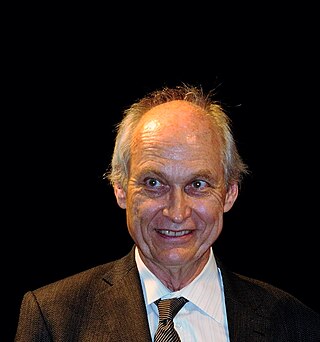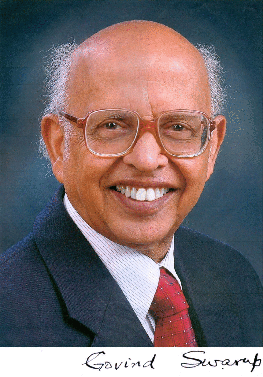
Michael S. Turner is an American theoretical cosmologist who coined the term dark energy in 1998. He is the Rauner Distinguished Service Professor Emeritus of Physics at the University of Chicago, having previously served as the Bruce V. & Diana M. Rauner Distinguished Service Professor, and as the assistant director for Mathematical and Physical Sciences for the US National Science Foundation.

The Smithsonian Astrophysical Observatory (SAO) is a research institute of the Smithsonian Institution, concentrating on astrophysical studies including galactic and extragalactic astronomy, cosmology, solar, earth and planetary sciences, theory and instrumentation, using observations at wavelengths from the highest energy gamma rays to the radio, along with gravitational waves. Established in Washington, D.C., in 1890, the SAO moved its headquarters in 1955 to Cambridge, Massachusetts, where its research is a collaboration with the Harvard College Observatory (HCO) and the Harvard University Department of Astronomy. In 1973, the Smithsonian and Harvard formalized the collaboration as the Center for Astrophysics | Harvard & Smithsonian (CfA) under a single Director.

The Center for Astrophysics | Harvard & Smithsonian (CfA), previously known as the Harvard–Smithsonian Center for Astrophysics, is an astrophysics research institute jointly operated by the Harvard College Observatory and Smithsonian Astrophysical Observatory. Founded in 1973 and headquartered in Cambridge, Massachusetts, United States, the CfA leads a broad program of research in astronomy, astrophysics, Earth and space sciences, as well as science education. The CfA either leads or participates in the development and operations of more than fifteen ground- and space-based astronomical research observatories across the electromagnetic spectrum, including the forthcoming Giant Magellan Telescope (GMT) and the Chandra X-ray Observatory, one of NASA's Great Observatories.
Herbert Gursky was the Superintendent of the Naval Research Laboratory's Space Science Division and Chief Scientist of the E.O. Hulburt Center for Space Research.
Eric J. Chaisson is an American astrophysicist known for his research, teaching, and writing on the interdisciplinary science of cosmic evolution. He is a member of the Center for Astrophysics | Harvard & Smithsonian, teaches natural science at Harvard University and is an elected Fellow of the American Association for the Advancement of Science.

Alexander Dalgarno FRS was a British physicist who was a Phillips Professor of Astronomy at Harvard University.
Lisa Jennifer Kewley is an Australian Astrophysicist and current Director of the Center for Astrophysics | Harvard & Smithsonian. Previously, Kewley was Director of the ARC Centre of Excellence for All Sky Astrophysics in 3-D and ARC Laureate Fellow at the Australian National University College of Physical and Mathematical Sciences, where she was also a Professor. Specialising in galaxy evolution, she won the Annie Jump Cannon Award in Astronomy in 2005 for her studies of oxygen in galaxies, and the Newton Lacy Pierce Prize in Astronomy in 2008. In 2014 she was elected a fellow of the Australian Academy of Science. In 2020 she received the James Craig Watson Medal. In 2021 she was elected as an international member of the National Academy of Sciences. In 2022 she became the first female director of the Center for Astrophysics | Harvard & Smithsonian.
Irwin Ira Shapiro is an American astrophysicist and Timken University Professor at Harvard University. He has been a professor at Harvard since 1982. He was the director of the Center for Astrophysics | Harvard & Smithsonian from 1982 to 2004.
Alastair G. W. Cameron was an American–Canadian astrophysicist and space scientist who was an eminent staff member of the Astronomy department of Harvard University. He was one of the founders of the field of nuclear astrophysics, advanced the theory that the Moon was created by the giant impact of a Mars-sized object with the early Earth, and was an early adopter of computer technology in astrophysics.

Claire Ellen Max is a Professor of Astronomy and Astrophysics at the University of California, Santa Cruz (UCSC) and is affiliated with the Lick Observatory. She was the Director of the Center for Adaptive Optics at UCSC, 2007-2014. Max received the E.O. Lawrence Award in Physics.

Reinhard Genzel is a German astrophysicist, co-director of the Max Planck Institute for Extraterrestrial Physics, a professor at LMU and an emeritus professor at the University of California, Berkeley. He was awarded the 2020 Nobel Prize in Physics "for the discovery of a supermassive compact object at the centre of our galaxy", which he shared with Andrea Ghez and Roger Penrose. In a 2021 interview given to Federal University of Pará in Brazil, Genzel recalls his journey as a physicist; the influence of his father, Ludwig Genzel; his experiences working with Charles H. Townes; and more.

Katherine Freese is a theoretical astrophysicist. She is currently a professor of physics at the University of Texas at Austin, where she holds the Jeff and Gail Kodosky Endowed Chair in Physics. She is known for her work in theoretical cosmology at the interface of particle physics and astrophysics.

Govind Swarup was a pioneer in radio astronomy. In addition to research contributions in multiple areas of astronomy and astrophysics, he was a driving force behind the building of "ingenious, innovative and powerful observational facilities for front-line research in radio astronomy".
The Taiwanese–American Occultation Survey (TAOS) is a robotic survey of the Outer Solar System. TAOS uses an array of four 50 cm aperture telescopes to monitor background stars awaiting the alignment of an Outer Solar System with a star target: an occultation. Small objects in the Outer Solar System that are too small to be observed by direct observations at this time can be probed with this technique. Occultation surveys take advantage of diffraction effects during the transit of the occulting object in front of a background star to constraint the size and distance of the occulter. TAOS is sensitive to occultations by Kuiper Belt Objects (KBOs) larger than about 500 m in diameter and to Sedna-like objects.

William Henry Press is an astrophysicist, theoretical physicist, computer scientist, and computational biologist. He is a member of the U.S. National Academy of Sciences, the American Academy of Arts and Sciences, and the Council on Foreign Relations. In 1989, he was elected a Fellow of the American Physical Society "in recognition of important theoretical contributions to relativistic astrophysics and to cosmology" Other honors include the 1981 Helen B. Warner Prize for Astronomy. Press has been a member of the JASON defense advisory group since 1977 and is a past chair.

Belinda Jane Wilkes is a Senior Astrophysicist at the Smithsonian Astrophysical Observatory (SAO) in Cambridge, Massachusetts, US, and former director of the Chandra X-ray Center.
Patrick Thaddeus was an American professor and finished his career as the Robert Wheeler Willson Professor of Applied Astronomy Emeritus at Harvard University. He is best known for mapping carbon monoxide in the Milky Way galaxy and was responsible for the construction of the CfA 1.2 m Millimeter-Wave Telescope.

Whipple was a proposed space observatory in the NASA Discovery Program. The observatory would try to search for objects in the Kuiper belt and the theorized Oort cloud by conducting blind occultation observations. Although the Oort cloud was hypothesized in the 1950s, it has not yet been directly observed. The mission would attempt to detect Oort cloud objects by scanning for brief moments where the objects would block the light of background stars.

Vassiliki Kalogera is a Greek astrophysicist. She is a professor at Northwestern University and the director of the Center for Interdisciplinary Exploration and Research in Astrophysics (CIERA). She is a leading member of the LIGO Collaboration that observed gravitational waves in 2015.
Selma de Mink is a Dutch astrophysicist specializing in evolution of stars, stellar binary systems and compact objects, including black holes. She is a scientific director at the Max Planck Institute for Astrophysics in Garching near Munich, Germany.











